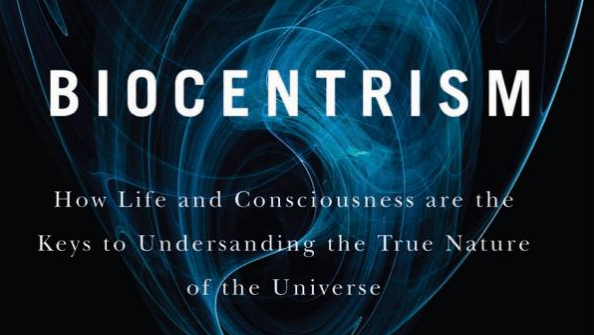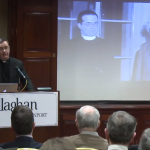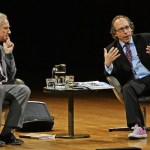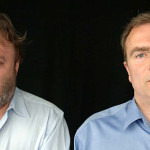Is Reality Just What We Think It Is?
by Dr. Benjamin Wiker
Filed under Anthropology
The human mind, by its nature, strives to know everything. But just because we have the desire to know everything, our reach often exceeds a sure grasp of reality, and we fall into fantasy. So it is with Robert Lanza's Biocentrism: How Life and Consciousness are the Keys to Understanding the True Nature of the Universe which offers a new and elaborate form of solipsism. The universe and everything in it, Lanza asserts confidently, exists because we perceive it. In his words, "the observer creates reality, and not the other way around." The moon exists only when we are looking at it. When we walk out of the kitchen, and turn our mind elsewhere, the kitchen is no longer there.
Here is Lanza's argument in a kind of syllogistic nutshell. On the smallest level, the submicroscopic level of quantum mechanics, our attempts to measure the location or momentum of subatomic particles results in a strange paradox. Particles exhibit both the qualities of particles and waves, although not both at once. They seem to be potentially both, but become actually one or the other only when we attempt to measure them. But we can only measure them either as waves or particles, but not both at once. The way we measure them determines the way they act.
Imagine it this way. You are on one side of a wall and a bit of light exists on the other. The wall has two doors, three feet apart, so you can't look through both at once. One door is marked "particle" and the other is marked "wave." You open the "particle" door, and the light acts like a particle. You slam the door shut, and run quickly to open the other door, and lo and behold, it now acts like a wave.
Therefore, concludes Lanza, the act of observing, of attempting to measure the light, actually causes it to move from a fuzzy state of probability (potentially either a particle or wave), to a crisp state of reality (actually either a particle or wave). In more technical, mathematical terms, observation causes the light to move from a wave function probability, to a wave function collapse. And so (brace yourself for a syllogistic leap), since everything is made of particles, then everything no matter how large—the moon, your kitchen, the universe—exists in a state of fuzzy probability until someone observes it.
Lanza buttresses his argument that our perception causes reality by several, more familiar arguments from ancient and modern skeptics that purport to show that "reality" should be kept in quotes. Things aren't really colored; color is merely the way our visual system paints things. There is no sound; what we call sound is only the effect that vibrations have on our ear. Given the vast empty spaces inside atoms, things made of atoms are not solid, but mostly space; we perceive things as solid only because we are too large to see the vast empty subatomic spaces. Furthermore, space and time aren't real entities outside us, but constructions from within us, helping us to divide up and order our experiences.
And so we come to the title of Lanza's book. Since we are biological beings, and our observation causes reality to appear (or at least to crystallize), the universe is therefore biocentric. In fact, Lanza proclaims, the universe appears to be so finely-tuned for life, especially for intelligent life, precisely because we are the ones that order it by our perception. Of course it seems to be made for intelligent perceivers. We are the ones creating it by our perception!
What to make of such an argument? Lanza is fantastically intelligent, but as with so many others similarly blessed, it leads him into fantasy. On the most practical level, Lanza's argument fails the bullet test. If Lanza's argument were true, then a bullet fired at someone would only kill him if he perceived it, and thereby brought the bullet from a fuzzy state of potentiality, to an actual state of penetrating his skull.
On a more theoretical level, Lanza suffers from a confusion of levels of reality. What is true on one level of reality does not necessarily pertain to another. The strangle paradoxes of quantum mechanics do not appear on the macroscopic level. We don't have a problem with measuring both the position and momentum of a bullet, in the same way that we have a problem measuring both the position and momentum of a subatomic particle.
The philosophical error at the bottom of Lanza's confusion of levels of reality is reductionist materialism. According to such reductionism, only atoms are real (or, peeling down further, only subatomic particles). If atoms aren't colored, then nothing has color. If atoms don't smell, odor isn't real. If atoms aren't solid, then all solidity vanishes. If subatomic particles behave in strange ways, then all appearances to the contrary, everything else really acts like subatomic particles.
But it ain't so. The truth is that each layer of reality, from the microscopic to the macroscopic, has its own integrity, building upon the layers below it even while it reveals its own amazing and real properties. Atoms are smaller than a wavelength of light, therefore they can't have color, but atoms in large, ordered aggregations are big enough to reflect light, and so make possible the reality of being colored. Solidity is not found on an atomic level, but the atomic level makes real solidity possible on the macroscopic realm. We calculate the position and momentum of ordinary objects all the time, from a baseball thrown by a pitcher or a missile shot from the deck of a warship, to the orbit of the moon or the schedule of a train. In fact, it is precisely the stability, solidity, and predictability of the macroscopic world that allows us to set up experimental equipment to measure the strange paradoxes of the submicroscopic world. The paradoxes are real, but then again, so are we, the equipment, the moon, the kitchen, and the universe.
Related Posts
Note: Our goal is to cultivate serious and respectful dialogue. While it's OK to disagree—even encouraged!—any snarky, offensive, or off-topic comments will be deleted. Before commenting please read the Commenting Rules and Tips. If you're having trouble commenting, read the Commenting Instructions.













